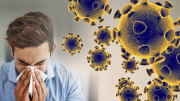The San Luis Valley is currently experiencing a spike in COVID-19 illness. There were 228 new cases reported in the past week.
CDC’s Community Level designation is Level High for Alamosa, Conejos, Mineral, Rio Grande, Costilla, and Saguache counties.
Please practice preventive measures. Information about local data, testing, and vaccination locations can be found at www.slvphp.com.
Beginning in July, there will be a change in COVID-19 testing options in the San Luis Valley. State supported mobile testing units that have been supplementing testing in Alamosa, La Jara, Antonito, and Saguache will be discontinued at the end of June. Mobile vaccine clinics are not affected and will continue to offer vaccines, as well as home test kits.
Local health care providers will continue to provide testing for their patients. Tests that go to a lab are the most accurate form of testing. Please utilize your medical provider if that is the best choice for you.
Tests for home use will be available more widely in the community to help fill the gap created by the loss of free testing sites. Currently, home test kits are available at no cost through state and federal resources because we are still in a federally declared public health emergency for COVID-19. Rapid home tests can also be purchased at pharmacies.
“We encourage each household to have a test kit at home so they can self-test if they have any COVID symptoms or test themselves 5 days after an exposure to COVID,” said Beverly Strnad, Interim Director of Alamosa County Public Health.
A limited number of free tests for each household can be ordered at no cost through the Federal COVID-19 testing program by calling 1-800-232-0233 (TTY 1-888-720-7489) or by going to covid.gov/tests. You may be able to pick up a home test kit at your local public health agency during regular business hours. Contact your local public health agency if your church, community organization, or business would like to sign up to become a community distribution point for free home tests kits.
Rapid tests have some advantages and some disadvantages in comparison to lab (PCR) tests. Rapid tests are quicker and less expensive, but they are less sensitive and therefore may be more prone to false negatives, especially early in the course of the infection. For this reason, most rapid test kits come with two tests in each box.
If your first at-home test is positive, this means that the proteins from the SARS-CoV-2 virus that causes COVID-19 were detected in your sample. These proteins are called antigens. If you have a positive test, stay away from others until your symptoms have improved and it has been at least 5 days since your symptoms started. If you test positive but you have no symptoms, you may still be infectious so stay away from others for five days after your positive test.
If you have symptoms but your first at-home test is negative, it is possible that there are not yet enough antigens in your system to be detected. Continue to isolate and follow the manufacturer’s instructions and take the second test 24-36 hours later.
Make sure to read the home test instructions carefully. The main test manufacturers have also provided short instructional videos that can be found with a quick internet search for “COVID rapid test instructions” followed by the brand name.
If you have a positive home test, please call the public health department in your county of residence to obtain guidance regarding next steps.
If you have a positive test and you are at high risk for developing severe illness, contact your health care provider to see if treatment is appropriate for you. Treatment that begins within 5 days of the onset of mild or moderate symptoms can reduce the likelihood of severe or long-term illness.
- Sunday, January 21st Weather - January 21, 2024
- Saturday, January 20th Weather - January 20, 2024
- Ark-Valley Humane Society Pet of the Week: Azula - January 17, 2024



